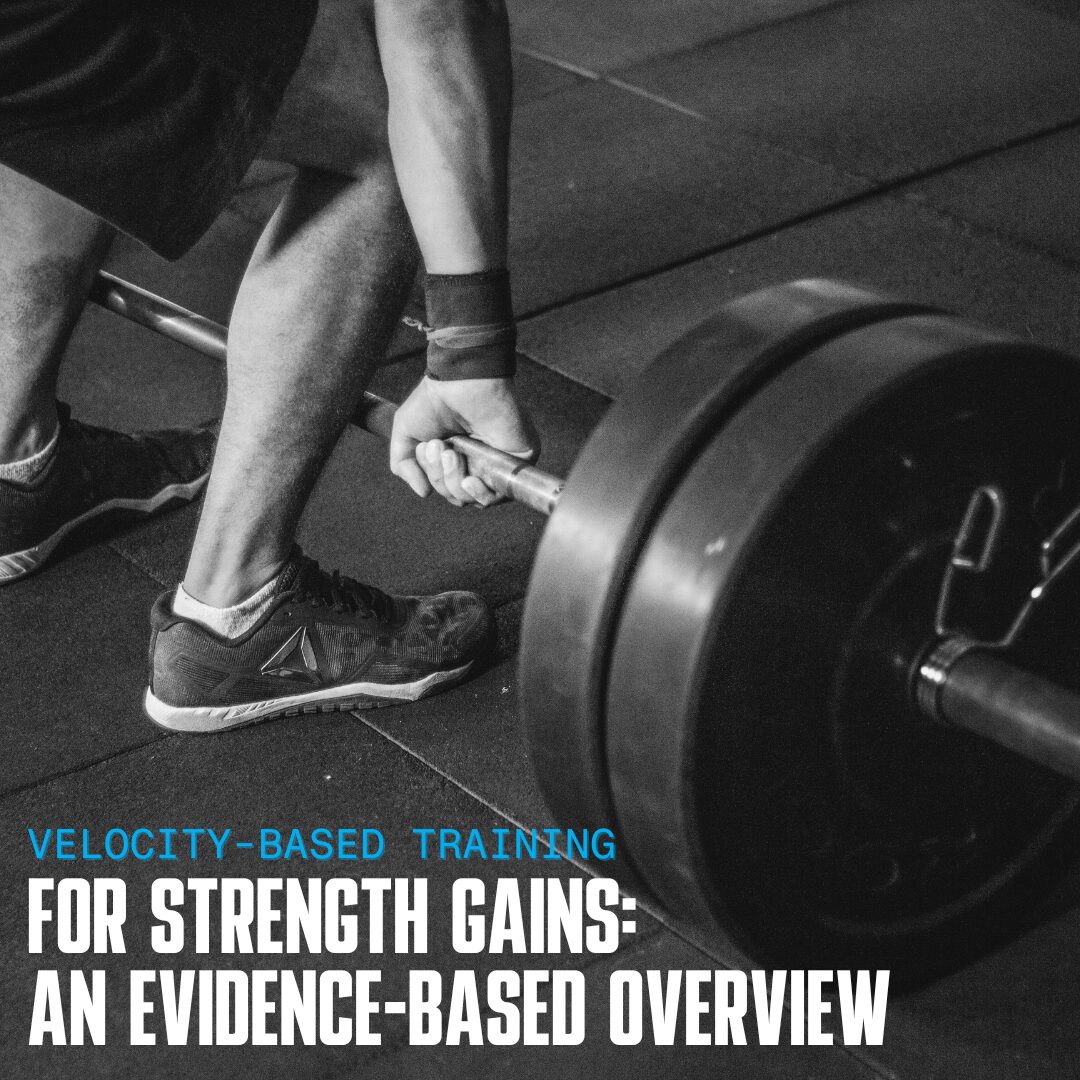Introduction
Strength training has traditionally relied on percentage-based prescriptions of an individual’s one-repetition maximum (1RM). However, this approach can be limited by day-to-day fluctuations in neuromuscular performance. Velocity-Based Training (VBT) has emerged as a progressive method to individualise training load and optimise strength adaptations by using movement velocity as a key metric (Mann et al., 2015). VBT leverages technology to provide real-time feedback and allows for auto-regulation based on the velocity of movement, which correlates strongly with load intensity and fatigue.
This paper explores the evidence supporting VBT for strength development, its physiological rationale, practical implementation, and its relationship with body composition assessment using Dual-Energy X-ray Absorptiometry (DEXA), particularly relevant in monitoring hypertrophy and fat-free mass gains over time.
Understanding Velocity-Based Training
VBT involves monitoring the speed at which a lift is performed, typically using linear position transducers or accelerometers. A key concept in VBT is the load-velocity relationship: as load increases, movement velocity decreases in a predictable manner (Jovanović & Flanagan, 2014). VBT exploits this relationship to tailor training load more precisely and provide real-time data that reflects the athlete’s readiness.
Training zones based on movement velocity are typically classified as:
- <0.5 m/s: Maximal strength
- 0.5–0.75 m/s: Strength-speed
- 0.75–1.0 m/s: Speed-strength
- >1.0 m/s: Maximal speed and power
The ability to autoregulate load based on movement velocity helps avoid overtraining and enhances day-to-day training precision.
Mechanisms Underpinning Strength Gains
Strength improvements from VBT are attributed to its ability to better match training intensity to neuromuscular status. Studies have demonstrated that training based on real-time velocity feedback enhances motor unit recruitment, movement intent, and adherence to target intensities (Pareja-Blanco et al., 2017). By adjusting loads based on velocity thresholds rather than static 1RM percentages, athletes train closer to their optimal daily capability, which may vary due to fatigue, stress, or sleep quality.
Furthermore, velocity loss thresholds—commonly set between 10–40% depending on the goal—serve as autoregulatory controls to manage fatigue. For instance, limiting a set when bar speed drops by 20% can maintain training quality and reduce unnecessary neuromuscular strain (Sánchez-Medina & González-Badillo, 2011).
Evidence for Strength Gains
Empirical research supports the efficacy of VBT for strength development. A pivotal study by Pareja-Blanco et al. (2017) compared two groups performing resistance training with either high (40%) or low (20%) velocity loss thresholds. Both groups improved in 1RM squat and bench press, but the low velocity loss group achieved greater improvements in maximal strength with less fatigue and training volume.
Another randomised controlled trial by Weakley et al. (2021) involving elite rugby athletes demonstrated that VBT led to significant improvements in strength and power metrics over traditional fixed-percentage training. Athletes trained with velocity feedback showed superior enhancements in vertical jump height and maximal squat strength.
These findings underscore the principle that not only can VBT match traditional methods in producing strength gains, it can also reduce cumulative fatigue and improve neuromuscular efficiency.
Application Across Populations
While much of the literature focuses on trained individuals, VBT also holds promise for novice and older populations. For example, Rodríguez-Rosell et al. (2017) applied VBT protocols in untrained individuals and observed robust gains in strength and muscle power. The adaptability of load through velocity feedback allows for safer progression, which is particularly beneficial for individuals with lower baseline strength or musculoskeletal concerns.
Moreover, age-related declines in strength can be mitigated with VBT. Research by Alegre et al. (2020) found that older adults who trained with velocity feedback improved strength and functional performance to a greater extent than those using conventional training, supporting its use in healthy ageing and rehabilitation contexts.
VBT and Muscle Hypertrophy: The Role of DEXA
While VBT is primarily associated with strength and power gains, its effect on muscle hypertrophy is also of interest. DEXA provides an accurate and reliable method to assess changes in lean body mass (LBM), fat mass, and bone mineral density over time, making it ideal for tracking outcomes of resistance training interventions (Nana et al., 2015).
Research integrating VBT with DEXA has shown promising results. For instance, a study by Pérez-Castilla et al. (2020) reported increases in LBM as measured by DEXA following an 8-week VBT programme in trained men. These gains were comparable to or exceeded those observed with traditional training, indicating that VBT is not only effective for strength but can support muscle growth.
The advantage of pairing VBT with DEXA lies in the capacity to monitor hypertrophic adaptations with high precision. DEXA scans provide regional and total body composition data, allowing practitioners to tailor programmes for specific outcomes, whether it’s increasing muscle in the limbs or preserving trunk lean mass.
Advantages and Limitations
Advantages:
- Individualisation: VBT adjusts load in real-time to reflect an athlete’s current neuromuscular capacity.
- Fatigue management: Velocity loss thresholds limit overreaching and reduce injury risk.
- Motivation and feedback: Real-time data fosters athlete engagement and performance tracking.
- Enhanced strength and power outcomes: Studies confirm superior neuromuscular adaptations.
Limitations:
- Equipment requirements: Access to linear position transducers or velocity sensors may be limited in general gyms.
- Learning curve: Athletes and coaches require training to interpret velocity data effectively.
- Data variability: Factors like bar path inconsistency or poor technique can influence velocity readings.
Practical Recommendations
For those implementing VBT:
- Use validated devices (e.g., GymAware, Tendo) to ensure reliable data.
- Establish individual load-velocity profiles to customise training zones.
- Apply lower velocity loss thresholds (10–20%) for strength-focused blocks.
- Integrate DEXA scans pre- and post-intervention to objectively track changes in LBM and assess effectiveness.
Conclusion
Velocity-Based Training offers a scientifically grounded, highly adaptable method for enhancing strength and muscular performance. By tailoring resistance training based on bar speed rather than static percentages, VBT provides a responsive, data-driven approach that aligns with the athlete’s daily physiological state. Its efficacy has been validated across a range of populations, and its application extends beyond strength to include hypertrophy when paired with tools like DEXA for detailed body composition analysis. As technology becomes more accessible, VBT is poised to become a staple in strength and conditioning programmes globally.
References
Alegre, L. M., Jiménez, F., Gonzalo-Carbonero, G., & Aguado, X. (2020). Effects of velocity-based resistance training on functional capacity and strength in older adults. Journal of Strength and Conditioning Research, 34(5), 1280–1288. https://doi.org/10.1519/JSC.0000000000003447
Jovanović, M., & Flanagan, E. P. (2014). Researched applications of velocity based strength training. Journal of Australian Strength and Conditioning, 22(2), 58–69.
Mann, J. B., Ivey, P. A., & Sayers, S. P. (2015). Velocity-based training in football. Strength & Conditioning Journal, 37(6), 52–57. https://doi.org/10.1519/SSC.0000000000000180
Nana, A., Slater, G. J., Hopkins, W. G., & Burke, L. M. (2015). Effects of daily activities on dual-energy X-ray absorptiometry measurements of body composition in active people. Medicine and Science in Sports and Exercise, 47(3), 537–544. https://doi.org/10.1249/MSS.0000000000000440
Pareja-Blanco, F., Rodríguez-Rosell, D., Sánchez-Medina, L., Gorostiaga, E. M., & González-Badillo, J. J. (2017). Effect of movement velocity during resistance training on neuromuscular performance. International Journal of Sports Medicine, 38(6), 442–450. https://doi.org/10.1055/s-0043-102933
Pérez-Castilla, A., Rojas, F. J., Gómez-Martínez, F., & García-Ramos, A. (2020). Comparison of muscle hypertrophy assessed by ultrasound and DEXA after velocity-based training. Journal of Strength and Conditioning Research, 34(11), 3013–3020. https://doi.org/10.1519/JSC.0000000000003402
Rodríguez-Rosell, D., Pareja-Blanco, F., Aagaard, P., & González-Badillo, J. J. (2017). Physiological and performance adaptations to low-volume strength training with or without velocity loss. Scandinavian Journal of Medicine & Science in Sports, 27(11), 1318–1329. https://doi.org/10.1111/sms.12728
Sánchez-Medina, L., & González-Badillo, J. J. (2011). Velocity loss as an indicator of neuromuscular fatigue during resistance training. Medicine and Science in Sports and Exercise, 43(9), 1725–1734. https://doi.org/10.1249/MSS.0b013e31821622dc
Weakley, J. J., Morrison, M. A., Garcia-Ramos, A., McLaren, S. J., Cronin, J. B., & Pearcey, G. E. (2021). The effects of velocity-based training on athletic performance: A systematic review and meta-analysis. International Journal of Sports Physiology and Performance, 16(3), 317–331. https://doi.org/10.1123/ijspp.2020-0173


